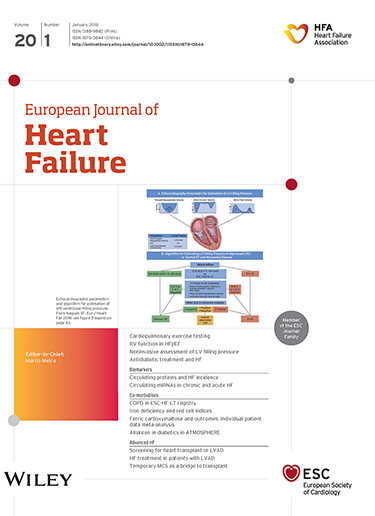A U-shaped relationship between left ventricular ejection fraction and risk of worsening heart failure.
IF 10.8
1区 医学
Q1 CARDIAC & CARDIOVASCULAR SYSTEMS
引用次数: 0
Abstract
AIMS Left ventricular ejection fraction (LVEF) is a key measure of cardiac function. While prior studies showed a U-shaped relationship between LVEF and mortality, its association with worsening heart failure (HF) remains unclear. We aimed to evaluate the association between the full spectrum of LVEF and the risk of worsening HF. METHODS AND RESULTS We analysed data from 93 694 consecutive participants (median age 62 years [interquartile range: 50-76 years], 51.4% men) undergoing echocardiography at a tertiary medical centre. LVEF, measured by biplane Simpson's method, was categorized into 5% intervals from <20% to ≥70%. The primary outcome was a composite of all-cause mortality or worsening HF, while the secondary outcomes included all-cause mortality, cardiovascular death, and worsening HF. The primary outcome occurred in 32 398 (34.6%) participants over a median follow-up of 8.3 years. A U-shaped relationship between LVEF and the primary outcome was observed, with a nadir at 60-70% and an increased risk when LVEF was ≥70% [adjusted hazard ratio (aHR) 1.12; 95% confidence interval (CI) 1.06-1.18]. Similar patterns were observed for the secondary outcomes. Participants with LVEF ≥70% also had a higher risk of worsening HF (aHR 1.13, 95% CI 1.03-1.23). This U-shaped association was consistent across subgroups stratified by age, sex, hypertension, and diabetes, and was observed for both incident and recurrent HF events. CONCLUSIONS Left ventricular ejection fraction demonstrated a U-shaped association with worsening HF, with the lowest risk at 60-70%. Supranormal LVEF (≥70%) identified a high-risk phenotype, underscoring the need for tailored management strategies for this subgroup.左心室射血分数与心力衰竭恶化风险呈u型关系。
目的:左室射血分数(LVEF)是衡量心功能的关键指标。虽然先前的研究显示LVEF与死亡率呈u型关系,但其与心力衰竭(HF)恶化的关系尚不清楚。我们的目的是评估全谱LVEF与心衰恶化风险之间的关系。方法和结果我们分析了93 694名在三级医疗中心接受超声心动图检查的连续参与者(中位年龄62岁[四分位数间距:50-76岁],51.4%为男性)的数据。LVEF采用双翼辛普森法测量,从<20%到≥70%分为5个区间。主要结局是全因死亡率或心衰恶化的综合结果,而次要结局包括全因死亡率、心血管死亡和心衰恶化。主要结局发生在33298名(34.6%)参与者中位随访8.3年。LVEF与主要结局之间呈u型关系,最低为60-70%,当LVEF≥70%时风险增加[校正风险比(aHR) 1.12;95%置信区间(CI) 1.06-1.18]。在次要结果中也观察到类似的模式。LVEF≥70%的参与者HF恶化的风险也更高(aHR 1.13, 95% CI 1.03-1.23)。这种u型关联在按年龄、性别、高血压和糖尿病分层的亚组中是一致的,并且在心衰事件和复发性心衰事件中都被观察到。结论左室射血分数与心衰恶化呈u型关系,最低风险为60-70%。异常LVEF(≥70%)是一种高风险表型,强调需要针对该亚组制定量身定制的管理策略。
本文章由计算机程序翻译,如有差异,请以英文原文为准。
求助全文
约1分钟内获得全文
求助全文
来源期刊

European Journal of Heart Failure
医学-心血管系统
CiteScore
27.30
自引率
11.50%
发文量
365
审稿时长
1 months
期刊介绍:
European Journal of Heart Failure is an international journal dedicated to advancing knowledge in the field of heart failure management. The journal publishes reviews and editorials aimed at improving understanding, prevention, investigation, and treatment of heart failure. It covers various disciplines such as molecular and cellular biology, pathology, physiology, electrophysiology, pharmacology, clinical sciences, social sciences, and population sciences. The journal welcomes submissions of manuscripts on basic, clinical, and population sciences, as well as original contributions on nursing, care of the elderly, primary care, health economics, and other related specialist fields. It is published monthly and has a readership that includes cardiologists, emergency room physicians, intensivists, internists, general physicians, cardiac nurses, diabetologists, epidemiologists, basic scientists focusing on cardiovascular research, and those working in rehabilitation. The journal is abstracted and indexed in various databases such as Academic Search, Embase, MEDLINE/PubMed, and Science Citation Index.
 求助内容:
求助内容: 应助结果提醒方式:
应助结果提醒方式:


